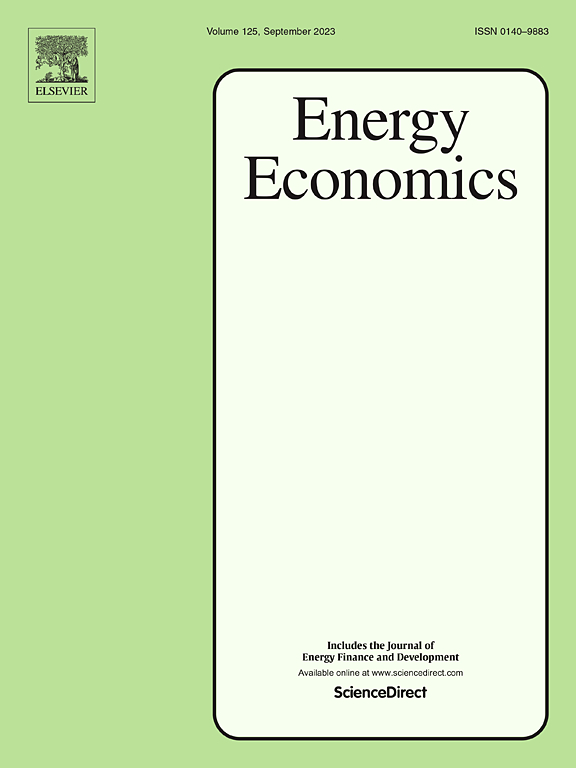碳中和的数字路径:中国基于地方的数字政策的碳减排效果研究
IF 13.6
2区 经济学
Q1 ECONOMICS
引用次数: 0
摘要
数字地域性政策以数据要素为核心,通过数字基础设施建设、数字技术应用和数字产业建设,推动区域经济由传统模式向数字化、智能化转型。本文以中国数字经济创新发展试验区(DEIDPZ)政策为研究对象,利用2015 - 2021年中国281个城市的面板数据,运用差中差(DID)模型对数字地基政策的碳减排效果进行研究。研究发现,试点城市的人均二氧化碳排放量减少了2.69%,碳减排效果显著。机制分析表明,配置效应、技术效应和集聚效应是DEIDPZ政策促进碳减排的主要中介效应。数字金融和公众环境关注在DEIDPZ政策降低CO2的过程中起调节作用。异质性分析表明,东部城市、资源型城市、行政级别高的城市、经济发展水平高的城市,以及浙江省和广东省,DEIDPZ政策的减排效果更为显著。我们的研究结果为数字化转型对可持续发展的影响提供了新的见解,并激励政策制定者使用基于数字的地方政策来实现碳中和目标。本文章由计算机程序翻译,如有差异,请以英文原文为准。
The digital path to carbon neutrality: Examining the carbon abatement effect of digital place-based policy in China
Digital place-based policy takes data elements as the core and promotes the transformation of the regional economy from traditional mode to digitalization and intelligence through the construction of digital infrastructure, digital technology applications and digital industries. This paper takes China’s digital economy innovation and development pilot zone (DEIDPZ) policy, a typical digital place-based policy, as the research object, and utilizes the panel data of 281 cities in China from 2015 to 2021 to study the carbon abatement effect of the digital place-based policy by using a difference-in-differences (DID) model. We find that the DEIDPZ policy has a significant carbon abatement effect, resulting in a 2.69% reduction in per capita CO2 emissions for the pilot cities. Mechanism analysis reveals that allocation, technical and agglomeration effects are the main mediators of the DEIDPZ policy in facilitating carbon abatement. It is also demonstrated that digital finance and public environmental attention play moderating roles in the process of the DEIDPZ policy reducing CO2. Heterogeneity analysis indicates that the carbon abatement effect of DEIDPZ policy is more significant in eastern cities, resource-based cities, cities with high administrative levels, and cities with high economic development levels, as well as in Zhejiang Province and Guangdong Province. Our findings offer new insights into the sustainability impact of digital transformation, as well as inspire policy-makers to use digital place-based policy to achieve carbon neutrality targets.
求助全文
通过发布文献求助,成功后即可免费获取论文全文。
去求助
来源期刊

Energy Economics
ECONOMICS-
CiteScore
18.60
自引率
12.50%
发文量
524
期刊介绍:
Energy Economics is a field journal that focuses on energy economics and energy finance. It covers various themes including the exploitation, conversion, and use of energy, markets for energy commodities and derivatives, regulation and taxation, forecasting, environment and climate, international trade, development, and monetary policy. The journal welcomes contributions that utilize diverse methods such as experiments, surveys, econometrics, decomposition, simulation models, equilibrium models, optimization models, and analytical models. It publishes a combination of papers employing different methods to explore a wide range of topics. The journal's replication policy encourages the submission of replication studies, wherein researchers reproduce and extend the key results of original studies while explaining any differences. Energy Economics is indexed and abstracted in several databases including Environmental Abstracts, Fuel and Energy Abstracts, Social Sciences Citation Index, GEOBASE, Social & Behavioral Sciences, Journal of Economic Literature, INSPEC, and more.
 求助内容:
求助内容: 应助结果提醒方式:
应助结果提醒方式:


